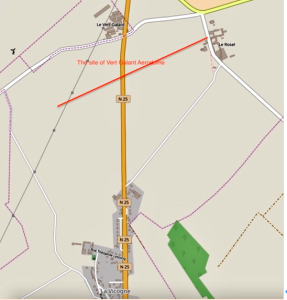1st and 2nd April 1918 Monday and Tuesday
No Fooling Today, Instead a Difficult Train Journey
All material produced or reproduced here and throughout this work is the sole copyright of the author and the family of Doctor D.C.M. Page MC.
“On Monday, 1st April, we marched to Calonne where we entrained. It was hard work getting the horses on board. The train left at 12.10 a.m. on 2nd April, and we were in the train until noon. We detrained at Doullens, very dirty, tired and hungry.
However, we got no respite until we had marched 8 miles along the main Doullens-Amiens road to a little village named La Vicogne. Our men were under canvas in a field, whilst the officers slept on the floor of a room of a big farmhouse. There was a large aerodrome near us. The road was very busy with transport of all kinds.
We were now in the 5th Corps with the 2nd, 12, 17th, 47th, 63rd and 1st New Zealand Divisions, and are in 3rd Army reserve.”
Douglas so far, hadn’t mentioned his recent inhalation of gas received during the attack on the 11th March. Three weeks had passed, but typically for him he makes no mention of it, although it must have been troubling him. A few mouthfuls would not have exactly gone unnoticed.
The work of a Captain in the Royal Army Medical Corps had proved difficult enough but also varied in his duties. Instead of attending to the sick and wounded, it was now necessary to help load reluctant horses into a train and commence another slow journey south. Today this 68 kilometre journey is no longer possible by train.
Douglas and the men he looked after were ordered south to Doullens as part of the effort of attempting to plug the gap caused by the breakthrough of German forces following the start of Operation Michael (The first part of the Kaiser’s Spring Offensive) on the 21st March. Sixteen divisions of the British army were now faced by fifty eight German divisions. Many of them battle hardened, but had had some rest time after withdrawal from the east. They had spent time training in their occupied lands behind the front line since their arrival.
The nearby large aerodrome was Vert Galant. It had been gradually expanding since being established in 1915 with the Royal Flying Corps and the Royal Navy Air Service, eventually with the Royal Air Force. It operated until 1919.
The Book by Michael O’Connor “In the Footsteps of the Red Baron” gives the very interesting and full history of Vert Galant.
Find out about our connection with Dr Page and an introduction to his diary here
